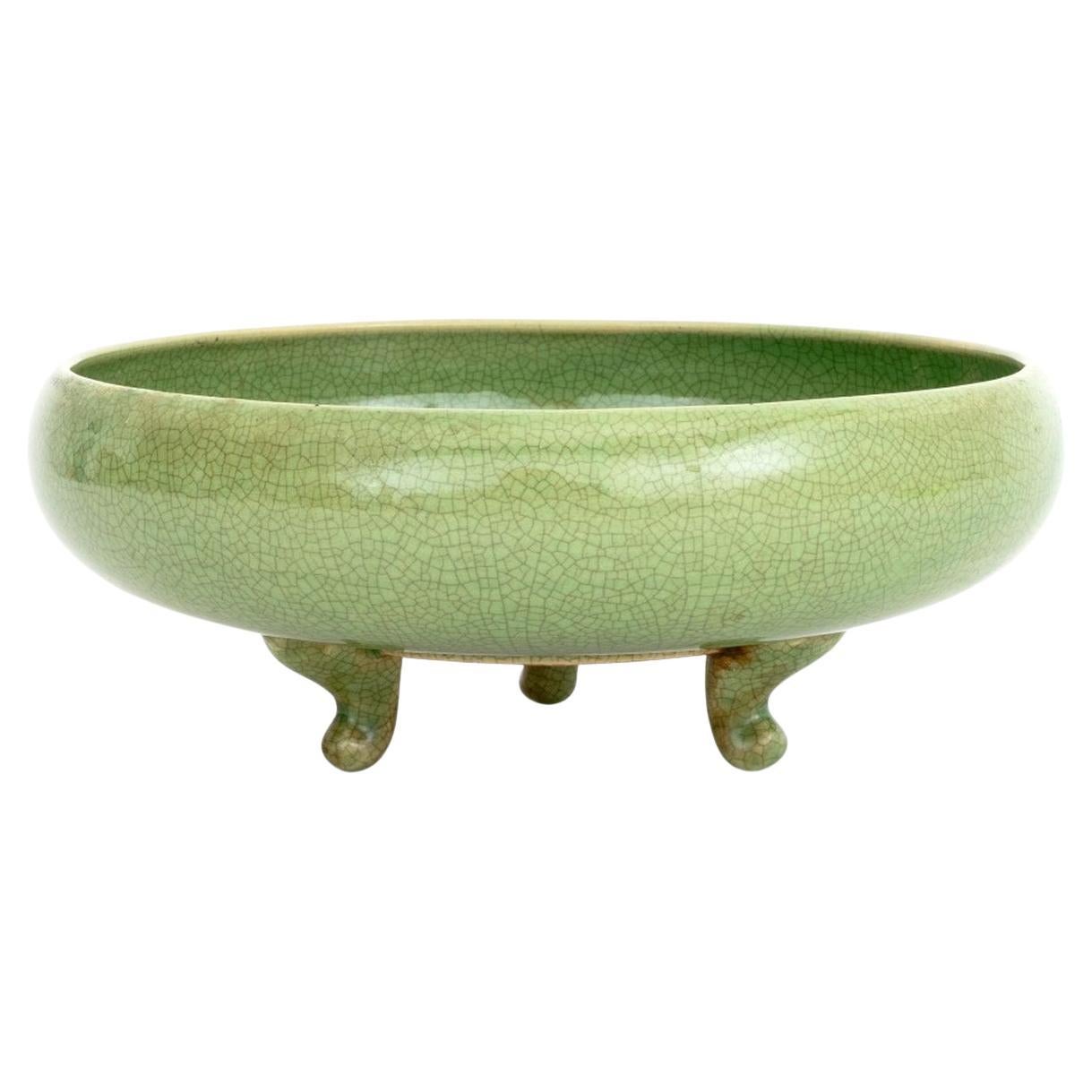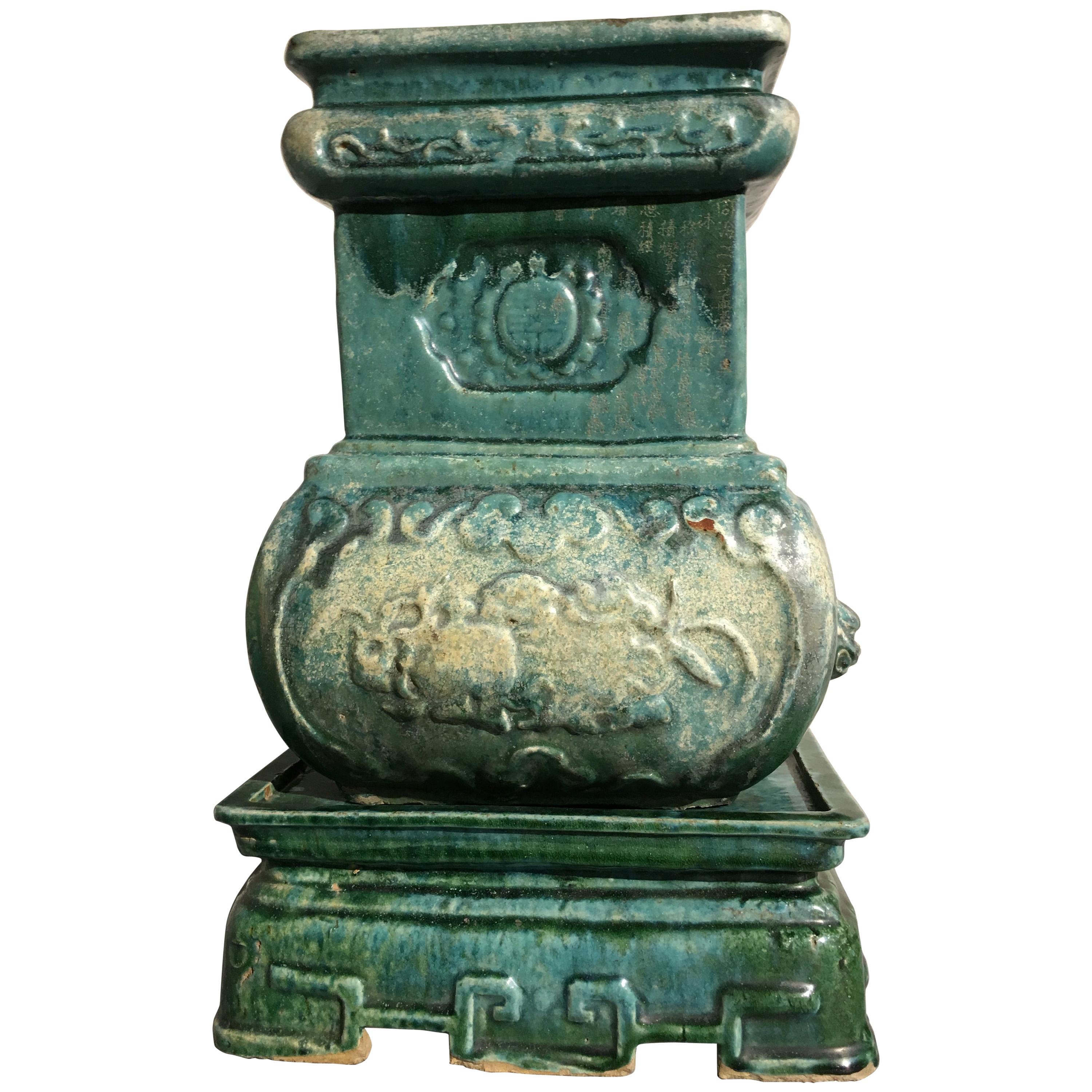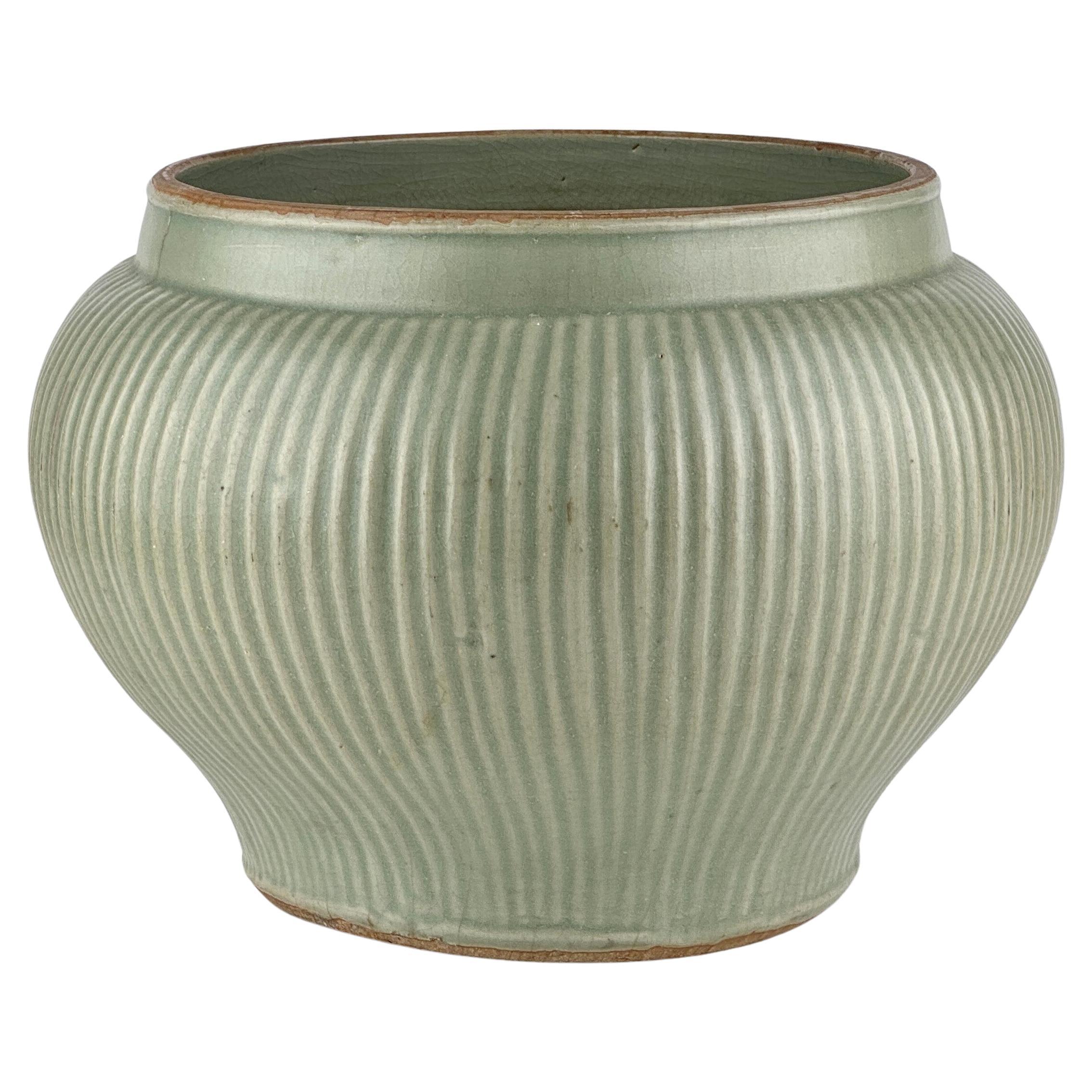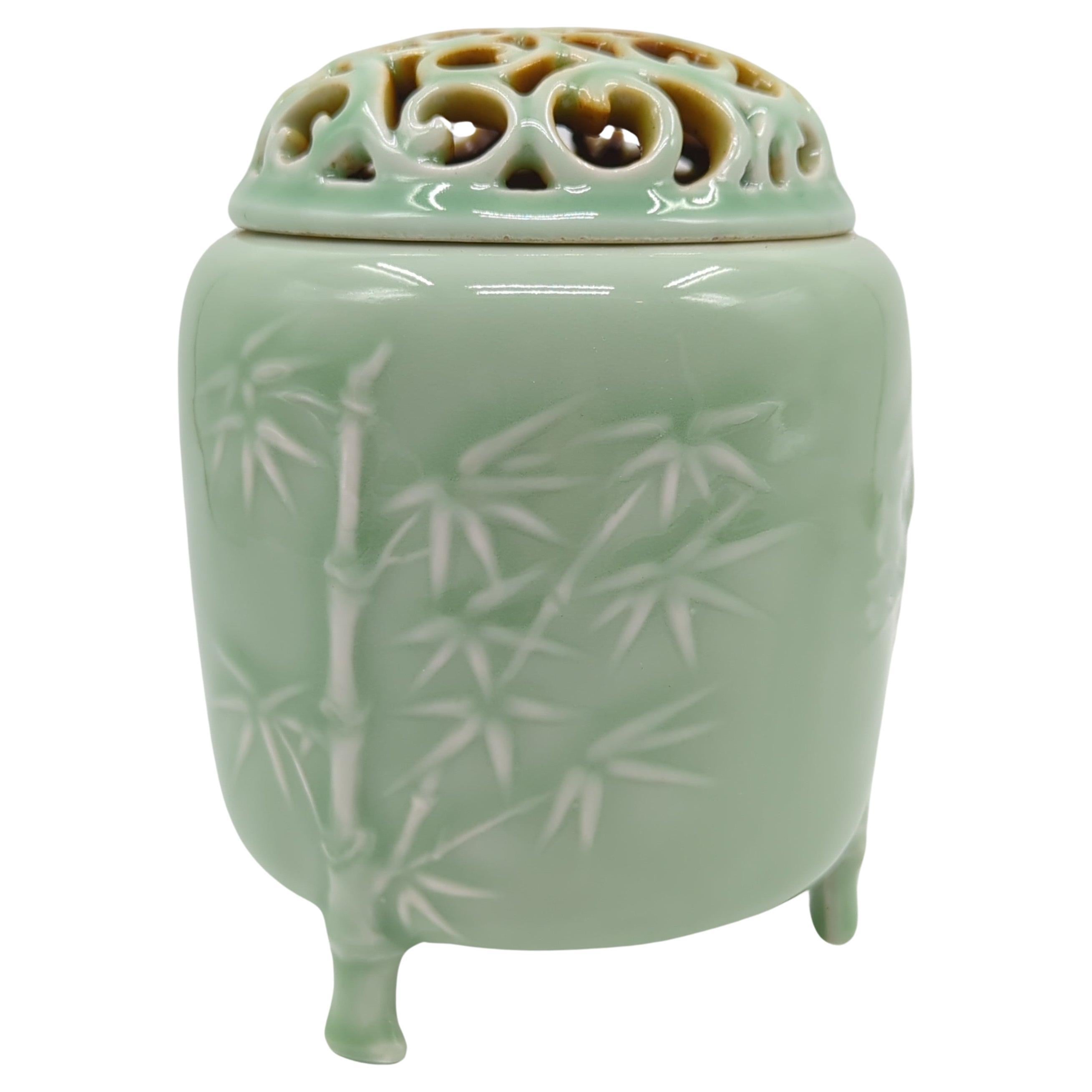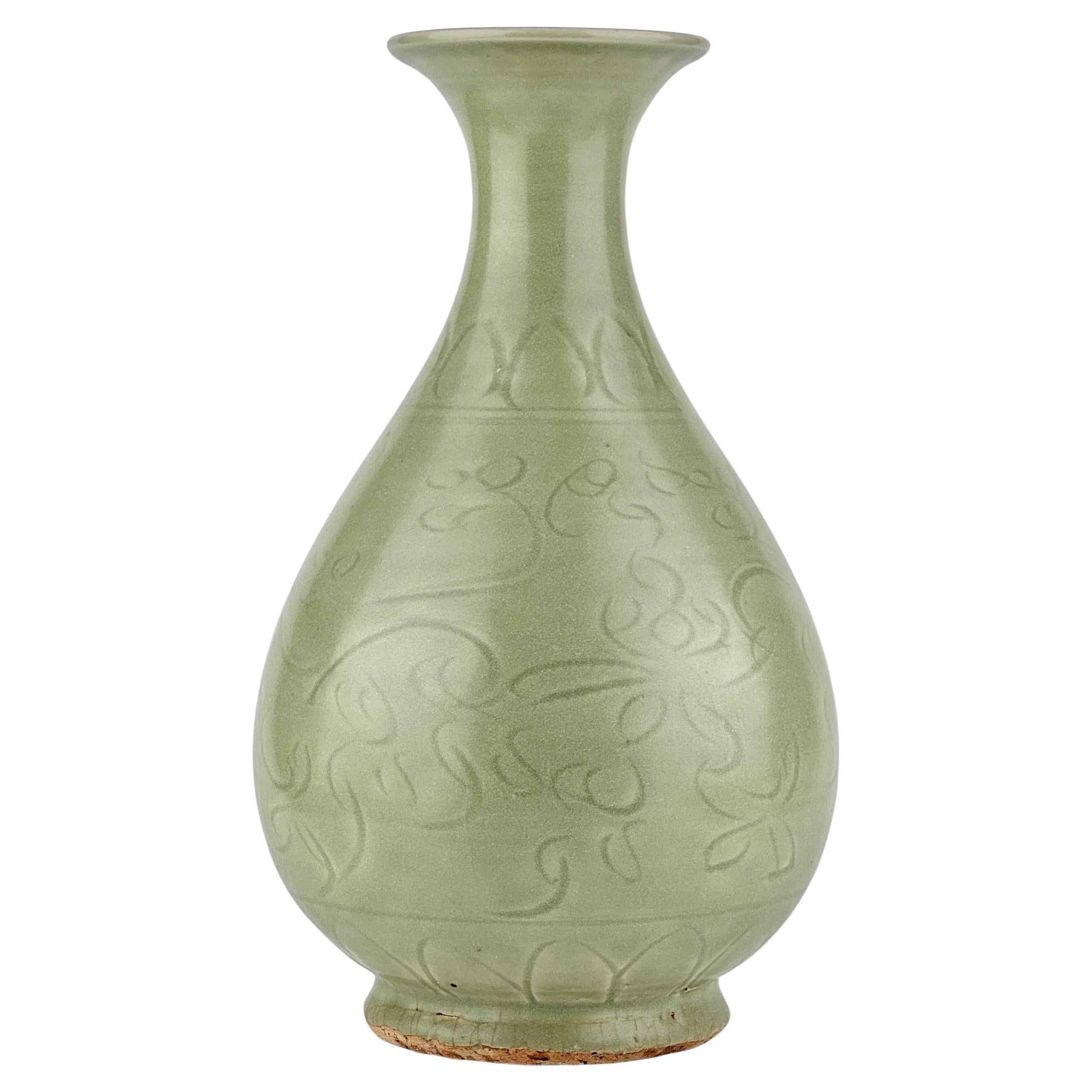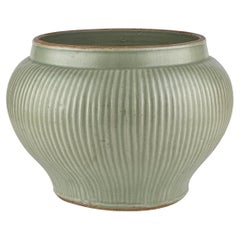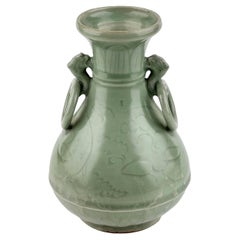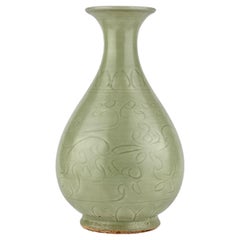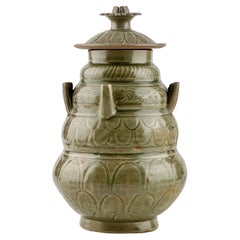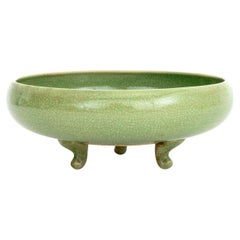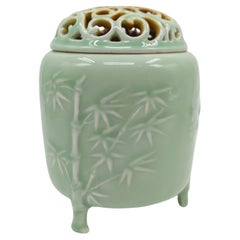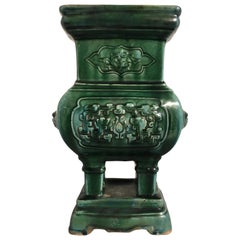Items Similar to Rare Longquan Celadon Tripod Incense Burner, Song-Yuan Dynasty
Want more images or videos?
Request additional images or videos from the seller
1 of 13
Rare Longquan Celadon Tripod Incense Burner, Song-Yuan Dynasty
$17,500
$35,00050% Off
£13,227.83
£26,455.6650% Off
€15,201.13
€30,402.2650% Off
CA$24,368.64
CA$48,737.2850% Off
A$27,109.12
A$54,218.2350% Off
CHF 14,210.94
CHF 28,421.8850% Off
MX$331,266.78
MX$662,533.5650% Off
NOK 180,958.57
NOK 361,917.1450% Off
SEK 170,347.46
SEK 340,694.9250% Off
DKK 113,470.67
DKK 226,941.3350% Off
Shipping
Retrieving quote...The 1stDibs Promise:
Authenticity Guarantee,
Money-Back Guarantee,
24-Hour Cancellation
About the Item
The vessel features a compressed body supported by three tapered feet and a flat, outwardly flaring rim. Three slender flanges originate from a subtle ridge on the shoulder and extend gracefully down each leg. The entire censer is adorned with a lustrous, uniform sea-green glaze.
Period : Southern Song Dynasty - Yuan Dynasty
Type : Celadon
Medium : Longquan ware
Provenance : Acquired in early 2000s from Japan
Reference :
1) Sotheby's Hongkong 29 April 2022 - Important Chinese Art including Jades from the De An Tang Collection and Gardens of Pleasure – Erotic Art from the Bertholet Collection - Lot 3601
(Price realised : 819,000 HKD / Type : Closely related)
2) Christies Newyork 22–23 MAR 2018 - Fine Chinese Ceramics and Works of Art - Lot 709
(Price realised : 187,500 USD / Type : Closely related)
* Song Dynasty Longquan Celadon
Longquan celadon refers to a type of Chinese ceramic that was famous for its distinctive glaze and high-quality craftsmanship, primarily produced during the Song Dynasty (960–1279 AD). These ceramics were made in the Longquan region of the Zhejiang province in eastern China, an area rich in the clay and mineral resources necessary for ceramic production.
The most notable characteristic of Longquan celadon is its glaze, which ranges in color from a pale blue-green to a deep olive green. This unique color comes from the iron oxide in the glaze, which, when fired in a reducing kiln atmosphere, produces the green hue. The thickness of the glaze, as well as the firing conditions, could affect the final shade and appearance of the celadon, with some pieces exhibiting a more crackled texture and others a smoother, glossier finish.
Longquan celadons were highly prized for their beauty and durability, making them popular both domestically within China and internationally. They were exported widely, reaching as far as Southeast Asia, the Middle East, and Africa, where they were often considered luxury items and treasured by various cultures.
The designs of Longquan celadon wares varied from simple and elegant forms to more elaborate decorations, including carved or incised motifs inspired by nature, such as lotus flowers, phoenixes, dragons, and foliage. Despite the variations in decoration, the emphasis was always on the harmony between form, glaze, and decoration, with the glaze playing a crucial role in enhancing the overall aesthetic appeal of the piece.
During the Song Dynasty, Longquan celadon was one of several major types of ceramics produced in China, each with its own distinctive characteristics. However, the quality and beauty of Longquan celadon made it one of the era's most celebrated ceramic types, and it continues to be highly valued by collectors and scholars today.
- Dimensions:Height: 5.12 in (13 cm)Diameter: 5.12 in (13 cm)
- Materials and Techniques:Celadon,Glazed
- Place of Origin:
- Period:
- Date of Manufacture:12-14th century
- Condition:Minor fading. The piece was discovered with its surface damaged. However, it has since been robustly restored.
- Seller Location:seoul, KR
- Reference Number:1stDibs: LU9577243018552
About the Seller
4.8
Gold Seller
Premium sellers maintaining a 4.3+ rating and 24-hour response times
Established in 1999
1stDibs seller since 2023
38 sales on 1stDibs
Typical response time: <1 hour
- ShippingRetrieving quote...Shipping from: seoul, Korea South
- Return Policy
Authenticity Guarantee
In the unlikely event there’s an issue with an item’s authenticity, contact us within 1 year for a full refund. DetailsMoney-Back Guarantee
If your item is not as described, is damaged in transit, or does not arrive, contact us within 7 days for a full refund. Details24-Hour Cancellation
You have a 24-hour grace period in which to reconsider your purchase, with no questions asked.Vetted Professional Sellers
Our world-class sellers must adhere to strict standards for service and quality, maintaining the integrity of our listings.Price-Match Guarantee
If you find that a seller listed the same item for a lower price elsewhere, we’ll match it.Trusted Global Delivery
Our best-in-class carrier network provides specialized shipping options worldwide, including custom delivery.More From This Seller
View AllA Rare Longquan Celadon 'Hundred Rib' Jar, Song-Yuan Dynasty
Located in seoul, KR
This beautifully crafted jar features a wide baluster form, swelling gracefully from a short and slightly tapered foot. The design is accentuated by slender, elegant vertical ribs th...
Category
Antique 15th Century and Earlier Hong Kong Antiquities
Materials
Celadon
$15,000 Sale Price
25% Off
Carved Longquan Celadon Vase, Yuan-Ming Dynasty
Located in seoul, KR
A graceful baluster form with a flared mouth, a rounded body, and a slightly raised foot. The vase features two intricate handles in the shape of animal figures holding large looped ...
Category
Antique 15th Century and Earlier Hong Kong Ming Antiquities
Materials
Celadon
$4,900 Sale Price
30% Off
A Large Carved Longquan Celadon Yuhuchunping, Yuan-Ming Dynasty
Located in seoul, KR
The bulbous body is adorned with elegantly carved floral motifs, with intertwining vines and flowers forming a natural, flowing pattern. The base is left unglazed. Base surface crack...
Category
Antique 15th Century and Earlier Indonesian Ming Antiquities
Materials
Celadon
$9,750 Sale Price
35% Off
A Longquan Celadon Five-spouted Jar, Northern Song Dynasty (960~1127)
Located in seoul, KR
The jar features a round body with well-proportioned four distinct tiers and a short, stable foot. The surface is coated in a deep green Longquan celadon glaze, showcasing the sprout...
Category
Antique 15th Century and Earlier Hong Kong Antiquities
Materials
Celadon
$6,175 Sale Price
35% Off
Longquan Celadon 'Lotus Petal' Jar And Cover, Northern Song Dynasty)
Located in seoul, KR
The jar is sturdily potted with an oval shaped body carved with overlapping lotus petals below the straight neck. All covered with a crackled glaze of olive-green color with the exce...
Category
Antique 15th Century and Earlier Hong Kong Antiquities
Materials
Celadon
$3,495 Sale Price
50% Off
A Rare Longquan Celadon 'Peony' Vase Yuan-Ming Dynasty
Located in seoul, KR
This vase features a traditional vase coated with a clear and rich green celadon glaze. A fine network of crazing covers the surface. The neck is adorned with raised vine motifs, whi...
Category
Antique 15th Century and Earlier East Asian Ming Antiquities
Materials
Celadon
$57,850 Sale Price
35% Off
You May Also Like
Chinese Longquan Type Porcelain Tripod Censer
Located in Astoria, NY
Chinese Longquan Type Celadon Glazed Porcelain Tripod Censer, on three scrolled feet. 3.25" H x 8.25" Diameter. Provenance: From the Upper East Side Apartment of a Former Ambassador.
Category
Antique 19th Century Chinese Qing Ceramics
Materials
Porcelain
Chinese Qing Dynasty Green Glazed Pottery Incense Burner, Dated 1863
Located in Austin, TX
A gorgeous green glazed large Chinese pottery censer of Archaistic shape called a fanghu, set on a separate stand, Qing dynasty, second year of Tongzhi, 1863.
The censer or incense burner crafted in two parts and covered in a thick, runny and unctuous glaze, ranging from dark green to turquoise green, to pale celadon. The neck with shou (longevity) medallions. The body decorated in relief with fruit, pomegranate and finger citron (Buddha's hand). The sides fitted with lion mask handles. The stand with a key fret design, and a pierced Chinese...
Category
Antique 1860s Chinese Qing Ceramics
Materials
Pottery
Fine Chinese Celadon Glaze Relief Carved Covered Censer on Tripod Feet mid-20c
Located in Richmond, CA
This exceptional covered censer is a testament to the art of Chinese ceramics, executed with remarkable skill and attention to detail. The piece is enveloped in a refined celadon gla...
Category
Mid-20th Century Chinese Qing Ceramics
Materials
Porcelain
Chinese Qing Dynasty Green Glazed Incense Burner, Late 19th Century
Located in Austin, TX
A charming Chinese green glazed pottery censer or incense burner, Qing Dynasty, late 19th century. Now suitable for use as a jardiniere or vase.
The incense burner in glazed a deep green, in imitation of bronze models, and set on four tapered legs attached to a rectangular stand...
Category
Antique Late 19th Century Chinese Qing Planters, Cachepots and Jardinières
Materials
Pottery
Small Chinese Celadon Glazed Porcelain Kendi, Qing Dynasty, 18th Century, China
Located in Austin, TX
A darling small Chinese celadon glazed kendi, or pouring vessel, mid Qing Dynasty, 18th century, China, for the Southeast Asian market.
The diminutive kendi of typical form, with ...
Category
Antique 18th Century Chinese Qing Ceramics
Materials
Porcelain
Vietnamese Celadon Lotus Vessel, Ly or Tran Dynasty, 13th/14th Century, Vietnam
Located in Austin, TX
An unusually large Vietnamese celadon glazed stoneware bowl with carved lotus petal design, Ly or Tran Dynasty, 13th - 14th century, Vietnam.
The large bowl or offering vessel of generous proportions, rising on a short, unglazed foot ring, revealing the reddish buff stoneware body. The globular body elegantly tapered. The lower section deeply carved with a traditional stylized lotus petal design, a band of incised lines above. The upper section of the vessel ribbed, and carved with long, elegant lotus petals that taper upwards, terminating in rounded ends. Another band of incised lines circumscribe the mouth.
The vessel glazed in a wonderful olive celadon glaze. The glaze stopping neatly at the mouth rim. The transparent celadon glaze thinning slightly along the raised sections, and pooling in the recesses, adding additional depth and texture. The celadon with wonderful yellow undertones, giving an overall olive hue.
Reference: For four similar, but smaller examples, all dated 13th-14th century, see Stevenson & Guy, "Vietnamese Ceramics...
Category
Antique 15th Century and Earlier Vietnamese Ceramics
Materials
Stoneware
More Ways To Browse
Green Celadon
Antique Burners
Celadon And Blue
Antique Incense
Song Dynasty
Chinese Song Dynasty
Song Dynasty Furniture
Antique Iron Glaze
Chinese Incense
Song Dynasty Ceramics
Chinese Ceramics Song Dynasty
Green Asian Vessels
Antique Erotic Furniture
14th Century China
Chinese 14th Century
Chinese Incense Burner
Chinese Dragon And Phoenix
Celadon Crackle
